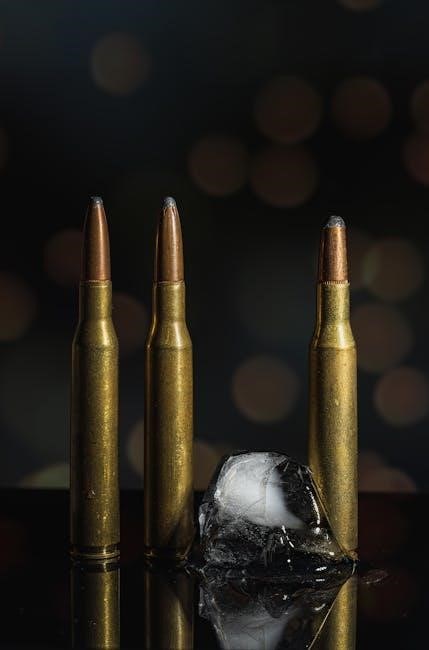Yamaha service manuals provide essential guidance for maintaining, repairing, and troubleshooting Yamaha products․ They include detailed instructions, diagrams, and specifications to ensure safe and effective service procedures․
Overview of Yamaha Service Manuals
Yamaha service manuals are comprehensive resources designed to help users maintain, repair, and troubleshoot Yamaha products effectively․ These manuals provide detailed instructions, diagrams, and specifications tailored to specific models, ensuring that both professionals and enthusiasts can handle various tasks with confidence․ They cover a wide range of topics, from routine maintenance schedules to complex repair procedures, and are essential for understanding the inner workings of Yamaha equipment․ By following the guidelines outlined in these manuals, users can ensure optimal performance, longevity, and safety of their Yamaha products․ They are indispensable for anyone looking to keep their Yamaha machinery in top condition․
Importance of Using Genuine Yamaha Manuals
Using genuine Yamaha service manuals is crucial for ensuring accuracy, safety, and reliability when maintaining or repairing Yamaha products․ These manuals are specifically designed by Yamaha experts, providing detailed, model-specific instructions that match the exact specifications of your equipment․ They include essential information such as wiring diagrams, error code identification, and troubleshooting steps, which are vital for resolving issues efficiently․ Genuine manuals also ensure compliance with safety standards and warranty requirements, protecting your investment and preventing potential risks․ Relying on authentic Yamaha documentation guarantees that you have the most up-to-date and accurate information, making it indispensable for both professionals and DIY enthusiasts․
Where to Find Yamaha Service Manuals
Yamaha service manuals can be found through various official and trusted sources․ The Yamaha Downloads website is a primary resource, allowing users to search for manuals by model and country․ Additionally, authorized Yamaha dealerships often provide access to genuine manuals, ensuring accuracy and reliability․ For older models, contacting Yamaha’s customer support can be effective, as they may have archived manuals or direct you to the appropriate resource․ While third-party websites and forums may offer manuals, caution is advised to ensure authenticity․ Online marketplaces like eBay or Amazon may also have manuals, but verifying the seller’s credibility is crucial․ Always prioritize official channels for genuine and reliable manuals․

Understanding Yamaha Diagnostic Software (YDS)
Yamaha Diagnostic Software (YDS) is a specialized tool for troubleshooting and maintaining Yamaha vehicles, offered on a USB drive with an interface harness for computer connectivity․
What is Yamaha Diagnostic Software (YDS)?
Yamaha Diagnostic Software (YDS) is a specialized tool designed to assist in diagnosing and repairing Yamaha vehicles․ It is typically provided on a USB drive and requires a compatible interface harness to connect the vehicle to a computer․ YDS allows users to access detailed diagnostic information, troubleshoot error codes, and perform system tests․ It is often referenced in service manuals for models like the 2022 MT-10, emphasizing its role in modern Yamaha maintenance․ The software is essential for understanding advanced technology and ensuring proper repairs, making it a crucial resource for both professionals and enthusiasts․ Regular updates may be necessary for optimal functionality․
How to Install and Use YDS
To install Yamaha Diagnostic Software (YDS), insert the provided USB drive into your computer and follow the on-screen instructions to download and install the software․ Once installed, connect your Yamaha vehicle to the computer using the required interface harness․ This setup enables communication between the vehicle and the diagnostic tool․ With YDS, users can access error codes, perform system tests, and troubleshoot issues․ The software is particularly useful for models like the 2022 MT-10, where it is frequently referenced for advanced diagnostics․ Regular software updates may be necessary to ensure compatibility and optimal performance․ Always refer to the official Yamaha guidelines for detailed instructions․
Troubleshooting with YDS
Yamaha Diagnostic Software (YDS) simplifies troubleshooting by identifying error codes and diagnosing system issues․ Users can access detailed information about firmware problems, such as those related to IC16, IC19, and IC23, which are common in models like the Tyros 4․ The software also aids in resolving maintenance issues by providing step-by-step repair procedures․ For example, it helps pinpoint electrical system faults and guides users through necessary adjustments․ YDS is particularly useful for diagnosing issues in motorcycles and outboard motors, ensuring accurate repairs․ By leveraging YDS, technicians and enthusiasts can efficiently address problems, reducing downtime and ensuring optimal performance․ Always use genuine Yamaha documentation for precise troubleshooting․

Model-Specific Service Manuals
Model-specific Yamaha service manuals cover motorcycles, outboard motors, and marine equipment, providing detailed repair and maintenance procedures tailored to each product line, ensuring precise diagnostics and repairs․
Yamaha Motorcycle Service Manuals
Yamaha motorcycle service manuals offer comprehensive guides for maintenance and repairs, tailored to specific models like the MT-10 and FZ6․ These manuals include detailed diagrams, troubleshooting steps, and part specifications, ensuring accurate diagnostics and fixes․ They cover engine breakdown procedures, electrical system checks, and advanced repair techniques․ Regular updates reflect new technologies, making them indispensable for both professionals and enthusiasts․ Use genuine Yamaha manuals to protect your investment and ensure safety․ They are available for various models, providing clear instructions for everyday use and complex overhauls․ Access these resources through official Yamaha websites or authorized dealers for reliable support․
Yamaha Outboard Motor Service Manuals
Yamaha outboard motor service manuals provide detailed instructions for maintaining and repairing outboard engines, including 4-stroke models like the 115 hp․ These manuals cover engine breakdowns, rigging, and electrical systems, ensuring proper care and extending lifespan․ They offer troubleshooting guides, part specifications, and maintenance schedules tailored to specific models․ Whether addressing common issues or complex overhauls, genuine Yamaha manuals are crucial for safe and effective repairs․ Access these resources through Yamaha’s official website or authorized dealers to ensure accurate and reliable information for your outboard motor․ Regular updates keep the manuals current with the latest technologies and service protocols․
Yamaha Marine Equipment Service Manuals
Yamaha marine equipment service manuals are tailored for various marine products, including outboard motors and boat systems․ These manuals offer comprehensive guidance on maintenance, repairs, and troubleshooting specific to marine applications․ They cover engine diagnostics, electrical wiring, and system testing․ Users can find detailed instructions for everyday operations and preparations, ensuring optimal performance and longevity․ The manuals are available in PDF format and can be accessed through Yamaha’s official website or authorized dealers․ They emphasize safety guidelines and proper handling of batteries and power supplies․ Regular updates ensure the manuals align with the latest technologies, providing reliable support for marine enthusiasts and professionals․ Yamaha’s commitment to quality ensures these manuals are indispensable for marine equipment care․

Tools and Equipment Needed for Yamaha Service
Essential tools for Yamaha maintenance include screwdrivers, wrenches, and multimeters․ Specialized tools, like interface harnesses, are required for advanced diagnostics and computer connectivity․
Essential Tools for Yamaha Maintenance
Essential tools for Yamaha maintenance include screwdrivers, wrenches, and multimeters․ These tools help diagnose and repair common issues efficiently․ Specialized tools, like interface harnesses, are needed for advanced diagnostics and connectivity․ Proper tools ensure safety and effectiveness in service procedures․
Specialized Tools for Advanced Repairs
Specialized tools are crucial for advanced Yamaha repairs, such as diagnostic software and interface harnesses․ These tools enable connectivity between Yamaha products and computers, facilitating detailed diagnostics and firmware updates․ The Yamaha Diagnostic Software (YDS) is essential for identifying error codes and system issues․ Additionally, specific harnesses and adapters are required to establish communication between devices․ These tools are designed to handle complex repairs efficiently, ensuring accuracy and safety․ They are particularly useful for troubleshooting firmware and electrical systems, making them indispensable for technicians and enthusiasts alike․ Proper use of these tools ensures effective maintenance and repair of Yamaha equipment․
Interface Harness for Computer Connectivity
An interface harness is essential for connecting Yamaha devices to computers, enabling diagnostic and repair processes․ It facilitates communication between Yamaha products and software tools like YDS (Yamaha Diagnostic Software)․ This harness ensures proper data transfer for troubleshooting, firmware updates, and system testing․ Compatible with various Yamaha models, it supports advanced maintenance tasks․ Correct installation and use of the harness are critical to avoid errors or damage․ Always opt for genuine Yamaha interface harnesses to ensure reliability and safety․ This tool is indispensable for technicians and enthusiasts performing complex repairs or maintenance, guaranteeing seamless connectivity and accurate diagnostics․

Troubleshooting Common Issues
Common issues with Yamaha devices often involve error codes, firmware glitches, or connectivity problems․ Using diagnostic tools and genuine manuals helps identify and resolve these issues efficiently․
Identifying Error Codes
Yamaha error codes are critical for diagnosing issues in motorcycles, outboards, and other equipment․ These codes, often displayed through the instrument cluster or diagnostic tools, indicate specific malfunctions․ Using Yamaha Diagnostic Software (YDS), users can retrieve and interpret error codes accurately․ The software, typically provided on a USB drive, connects to the vehicle via an interface harness, enabling detailed fault analysis․ Genuine service manuals complement this process by providing explanations for each code and repair procedures․ Regularly updating firmware and referring to official Yamaha resources ensures accurate diagnostics․ Always use genuine manuals and tools to maintain reliability and safety in troubleshooting and repairs․
Diagnosing Firmware Issues
Firmware issues in Yamaha products can often be diagnosed using the Yamaha Diagnostic Software (YDS)․ The software helps identify if firmware updates or repairs are needed․ By connecting the device to a computer via an interface harness, YDS can retrieve error codes and system information․ Firmware is typically stored in specific integrated circuits, such as IC16 or IC19, and updates are available through Yamaha’s official website․ Regular firmware checks ensure optimal performance and prevent operational failures․ Always use genuine Yamaha tools and manuals to avoid incorrect diagnoses and maintain system integrity․ Ensure the device is powered correctly during diagnostics to prevent further issues․
Resolving Common Maintenance Problems
Common maintenance issues with Yamaha products often involve oil changes, filter replacements, and electrical system checks․ Regular maintenance schedules outlined in service manuals ensure these tasks are performed correctly; For engine breakdowns, detailed repair procedures guide technicians through disassembly and reassembly․ Electrical system troubleshooting involves checking wiring diagrams for faults․ Yamaha’s diagnostic software (YDS) aids in identifying error codes linked to specific problems․ Always refer to genuine Yamaha manuals for accurate instructions to prevent further damage․ Proper handling of batteries and power supplies is crucial to avoid safety risks․ Adhering to these guidelines ensures optimal performance and longevity of Yamaha equipment․

Maintenance and Repair Guidelines
Yamaha service manuals provide detailed maintenance schedules, repair procedures, and troubleshooting guides․ Regular oil and filter checks, along with error code diagnostics, ensure optimal performance․ Referencing wiring diagrams and genuine Yamaha documentation guarantees accurate repairs and safety compliance․
Regular Maintenance Schedules
Yamaha service manuals outline regular maintenance schedules to ensure optimal performance and longevity of your vehicle or equipment․ These schedules include oil changes, filter replacements, and inspections of critical components like belts and coolant systems․ Detailed checklists are provided for specific intervals, such as every 500 to 5,000 miles, depending on the model․ Proper adherence to these schedules helps prevent mechanical failures and ensures safety․ Diagnostic tools, like Yamaha Diagnostic Software (YDS), can monitor systems and identify potential issues early․ Always refer to your model-specific manual for precise recommendations, as neglecting routine maintenance can lead to costly repairs and performance degradation․
Engine Breakdown and Repair Procedures
Yamaha service manuals provide detailed engine breakdown and repair procedures, ensuring precise steps for diagnosing and resolving issues․ From identifying error codes to replacing faulty components, the manuals guide users through complex tasks․ Specific instructions, including torque specifications and wiring diagrams, help technicians and enthusiasts alike perform accurate repairs․ The Yamaha Diagnostic Software (YDS) is often referenced for advanced diagnostics, while step-by-step procedures ensure safety and efficiency․ Whether addressing common faults or major overhauls, these manuals offer comprehensive solutions․ Always use genuine Yamaha parts and tools to maintain reliability and avoid further damage, ensuring your engine operates at peak performance for years to come․
Electrical System Troubleshooting
Yamaha service manuals offer comprehensive guides for diagnosing and repairing electrical system issues․ Detailed wiring diagrams and fault codes help identify problems quickly․ Troubleshooting steps include checking connections, fuses, and circuit integrity․ The Yamaha Diagnostic Software (YDS) aids in detecting issues by communicating with onboard systems․ Manuals emphasize proper testing tools and safety precautions to avoid further damage or injury․ By following the outlined procedures, users can systematically isolate and resolve electrical faults․ Regular maintenance schedules also help prevent common issues, ensuring optimal performance and reliability of Yamaha equipment․ Always refer to genuine manuals for accurate and safe electrical system troubleshooting and repairs․

Advanced Topics in Yamaha Service Manuals
Advanced topics cover complex repairs, wiring diagrams, and system adjustments․ Yamaha Diagnostic Software (YDS) aids in detailed diagnostics and firmware updates for optimal performance and reliability․
Understanding Wiring Diagrams
Wiring diagrams are crucial for diagnosing electrical issues in Yamaha products․ They provide a visual representation of the electrical system, showing connections between components․ These diagrams help technicians identify faulty circuits, trace wiring paths, and understand system integration․ By referencing Yamaha service manuals, users can accurately interpret symbols and colors, ensuring precise repairs․ Detailed diagrams cover everything from ignition systems to electronic controls, making them indispensable for both routine maintenance and complex troubleshooting․ Proper understanding of wiring diagrams enhances safety and efficiency, preventing potential damage or misinformation during service procedures․
System Testing and Adjustments
System testing and adjustments are critical steps in ensuring Yamaha products operate at peak performance․ Service manuals provide detailed procedures for diagnosing and calibrating electrical and mechanical systems․ Whether it’s adjusting ignition timing or fine-tuning engine performance, these guidelines ensure accuracy and safety․ Users can follow step-by-step instructions to test components like fuel injection systems, brakes, and suspension․ Proper adjustments prevent wear and tear, enhancing reliability․ Regular system checks help identify potential issues early, avoiding costly repairs․ By adhering to Yamaha’s specifications, technicians and enthusiasts can maintain optimal functionality and extend the lifespan of their equipment, ensuring consistent and dependable operation․
Operation and Preparations for Everyday Use
Proper operation and preparation are vital for maximizing the performance and longevity of Yamaha equipment․ Service manuals outline essential steps for daily use, including pre-operation checks and routine maintenance․ Users should always refer to model-specific guidelines for tasks like oil level checks, tire pressure adjustments, and battery maintenance․ Regular inspections help prevent unexpected issues, ensuring smooth operation․ For audio devices, manuals provide setup instructions for optimal sound quality and connectivity․ Before starting, familiarize yourself with safety precautions to avoid accidents․ Adhering to Yamaha’s recommendations ensures reliable performance, protects your investment, and guarantees a seamless user experience․ Preparation is key to enjoying your Yamaha product to its fullest potential․

Safety and Precautions
Always follow safety guidelines to prevent accidents and ensure proper equipment handling․ Be cautious with power supplies and avoid improper connections․ Adhering to Yamaha’s recommendations protects your investment and ensures reliable performance․
Safety Guidelines for Yamaha Equipment
Safety is paramount when working with Yamaha equipment․ Always disconnect power supplies and batteries before performing repairs to avoid electrical shocks or injuries․ Wear protective gear like gloves and goggles to prevent accidents․ Never connect devices to unauthorized power adapters, as this can cause damage or safety hazards․ Proper handling of electrical components is crucial to ensure both personal safety and equipment longevity․ Yamaha emphasizes adherence to these guidelines to protect users and maintain product reliability․ Following these precautions helps prevent potential risks and ensures efficient, safe servicing of Yamaha machinery․ Regular checks and adherence to manual instructions further enhance safety outcomes․
Consumer Protection and Safety Concerns
Yamaha prioritizes consumer safety and protection through comprehensive service manuals and guidelines․ Using genuine Yamaha manuals ensures compliance with safety standards, reducing risks of accidents or equipment damage․ Counterfeit manuals or unauthorized repairs can void warranties and compromise safety․ Yamaha’s official resources provide detailed instructions to maintain product integrity and user security․ Adhering to these guidelines helps protect consumers from potential hazards and ensures reliable performance․ Yamaha’s commitment to safety is evident in their documentation, emphasizing proper handling of electrical systems and power supplies․ Always rely on genuine Yamaha materials to safeguard your investments and uphold safety standards․ This approach ensures trust and satisfaction in Yamaha products․
Proper Handling of Batteries and Power Supplies
Yamaha service manuals emphasize the importance of safely handling batteries and power supplies to prevent damage and ensure user safety․ Always disconnect batteries before performing maintenance or repairs․ Avoid short circuits and improper connections, as they can cause irreversible damage․ Yamaha recommends using genuine parts and following specified charging procedures․ Never connect the product to an incorrect power supply or adapter, as this can lead to malfunction or fire hazards․ Proper storage and handling of batteries are crucial, especially for models with advanced electrical systems․ Follow the manual’s guidelines to maintain optimal performance and safety․ This ensures reliability and prevents potential risks associated with improper handling․

Official Yamaha Resources
Yamaha provides official resources for service manuals, diagnostic software, and repair guides through their downloads website and authorized dealers․ Access Yamaha Corporation of America resources and international sites for comprehensive support․
Yamaha Downloads Website
The Yamaha Downloads Website is a centralized platform offering official service manuals, diagnostic software, and repair guides․ Users can search by model, select their country, and access PDF documents for detailed maintenance and repair procedures․ This resource ensures authenticity and reliability, providing essential tools for technicians and enthusiasts․ The website is regularly updated, reflecting Yamaha’s commitment to supporting its products․ By using genuine manuals from this site, users can ensure compliance with safety standards and optimal performance․ This official resource is indispensable for anyone servicing Yamaha equipment;
Yamaha Corporation of America Resources
Yamaha Corporation of America provides extensive resources for service manuals, diagnostic tools, and repair guides․ Their official website offers OEM-certified documentation tailored for U․S․ models, ensuring compliance with local standards․ Users can access detailed manuals, wiring diagrams, and troubleshooting guides specific to their Yamaha products․ The resources are designed to support both technicians and enthusiasts, promoting safe and effective maintenance․ All manuals are available in English and cater exclusively to U․S․ models, ensuring clarity and relevance․ By utilizing these resources, users can maintain their Yamaha equipment with confidence, adhering to factory specifications and enhancing performance․ This ensures long-term reliability and customer satisfaction․
Accessing International Yamaha Sites
Accessing international Yamaha sites provides a wealth of resources for service manuals and diagnostic tools․ Yamaha Corporation of America redirects users to global sites for region-specific information․ The Yamaha Downloads website allows users to select their country and access model-specific manuals, ensuring compatibility with local standards․ International sites often offer manuals in multiple languages, catering to a global audience․ Additionally, regional troubleshooting guides and repair protocols are available, tailored to different markets․ Users can navigate through international forums and support networks for shared knowledge and solutions․ This global accessibility ensures that Yamaha enthusiasts and technicians worldwide can maintain and repair their equipment effectively, adhering to international safety and performance standards․
Yamaha service manuals are indispensable for maintaining and repairing Yamaha products, offering detailed guidance and ensuring optimal performance․ They provide essential resources for enthusiasts and technicians alike․
Final Thoughts on Yamaha Service Manuals
Yamaha service manuals are crucial for maintaining and repairing Yamaha products․ They offer detailed instructions, diagrams, and specifications to ensure safe and effective service․ These manuals are tailored to specific models, covering maintenance schedules, troubleshooting, and repair procedures․ By using genuine Yamaha manuals, users can protect their investments and ensure optimal performance․ The availability of these resources on official Yamaha websites and forums highlights their importance for enthusiasts and technicians․ Whether for motorcycles, outboard motors, or marine equipment, Yamaha service manuals provide the necessary tools for understanding and caring for Yamaha products effectively․ Regular updates ensure they remain relevant and comprehensive․
Encouragement to Use Genuine Yamaha Documentation

Using genuine Yamaha documentation ensures compliance with manufacturer standards, providing accurate and reliable information for maintenance and repairs․
It guarantees legal compliance and recognition by professionals, reducing risks of misinformation․
Investing in official manuals supports the manufacturer and ensures quality, making them indispensable for Yamaha owners and technicians․






























